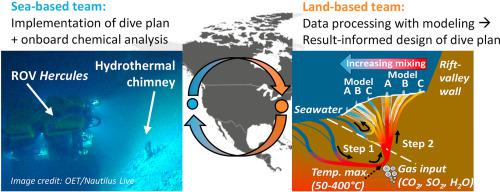当前位置:
X-MOL 学术
›
Planet. Space Sci.
›
论文详情
Our official English website, www.x-mol.net, welcomes your
feedback! (Note: you will need to create a separate account there.)
Forward Geochemical Modeling as a Guiding Tool During Exploration of Sea Cliff Hydrothermal Field, Gorda Ridge
Planetary and Space Science ( IF 1.8 ) Pub Date : 2021-03-01 , DOI: 10.1016/j.pss.2020.105151 Vincent Milesi , Everett Shock , Tucker Ely , Megan Lubetkin , Sean P. Sylva , Julie A. Huber , Amy R. Smith , Shannon Kobs Nawotniak , Zara Mirmalek , Christopher R. German , Darlene S.S. Lim
Planetary and Space Science ( IF 1.8 ) Pub Date : 2021-03-01 , DOI: 10.1016/j.pss.2020.105151 Vincent Milesi , Everett Shock , Tucker Ely , Megan Lubetkin , Sean P. Sylva , Julie A. Huber , Amy R. Smith , Shannon Kobs Nawotniak , Zara Mirmalek , Christopher R. German , Darlene S.S. Lim

|
Abstract Maximizing scientific return is critical to the success of space exploration. During the SUBSEA project, which explored the Sea Cliff vent site aboard the E/V Nautilus as an analog for hydrothermal systems on Ocean Worlds, we used forward geochemical modeling to guide decision-making during the process of exploration. Before the expedition, we performed 1670 reaction-path calculations to simulate water-rock interactions during hydrothermal circulation covering wide ranges of reaction conditions, to predict the diversity of possible chemical compositions and energy available for chemosynthetic microorganisms at the Sea Cliff vents. Calculation of the information entropy of predicted concentrations of major solutes and pH allowed us to identify dissolved silica as the chemical species capable of yielding the most information about reaction conditions, and so the measurement of this parameter was implemented aboard ship for our field-program. Using telepresence, results of onboard chemical analyses of fluid samples collected during seafloor Dive n were sent to our shore-based scientific team, who processed the data and used the outcomes to inform the design of Dive n+2. Combining data processing with forward modeling revealed, within just two dives, that all the observed fluids venting from 10 to 300°C most likely resulted from simple conservative mixing between seawater and a common hydrothermal fluid end-member: the result of reaction of seawater with basalt at ≥350°C. Identification of these reaction conditions early within the cruise allowed additional calculations to be performed to quantify the energy available from redox disequilibria as a function of vent-fluid temperatures as they exited the seafloor. These calculations can help inform and optimize real-time microbiological sampling and culture experiments onboard ship during field expedition. The success of our approach coupling forward modeling and onboard ship analyses allowed improved efficiency in completing of process studies at the Sea Cliff vent site, providing time for further exploration and sampling of an additional, newly discovered vent site: Apollo. This study demonstrates a novel application of forward and real-time modeling for scientific exploration which allows the time required for result-informed decision making to be reduced from years to hours – an essential breakthrough for future space exploration missions.
中文翻译:

正向地球化学建模作为戈达海岭海崖热液田勘探过程中的指导工具
摘要 最大化科学回报是太空探索成功的关键。在 SUBSEA 项目中,探索了 E/V Nautilus 上的海崖通风口作为海洋世界热液系统的模拟,我们使用正向地球化学模型来指导勘探过程中的决策。在探险之前,我们进行了 1670 次反应路径计算,以模拟涵盖广泛反应条件的热液循环过程中的水-岩相互作用,以预测海崖喷口处化学合成微生物可用的可能化学成分和能量的多样性。计算主要溶质的预测浓度和 pH 值的信息熵使我们能够将溶解的二氧化硅确定为能够产生有关反应条件的最多信息的化学物质,因此该参数的测量在船上进行,用于我们的现场计划。使用远程呈现,在海底 Dive n 期间收集的流体样本的船上化学分析结果被发送给我们的岸基科学团队,他们处理数据并使用结果为 Dive n+2 的设计提供信息。将数据处理与正向建模相结合,仅在两次潜水中发现,所有观察到的从 10°C 排放到 300°C 的流体最有可能是海水和常见热液流体端元之间的简单保守混合的结果:海水与玄武岩≥350°C。在巡航早期识别这些反应条件允许进行额外的计算,以量化氧化还原不平衡中可用的能量,作为它们离开海底时的排放流体温度的函数。这些计算可以帮助在实地考察期间通知和优化船上的实时微生物采样和培养实验。我们将前向建模和船上分析相结合的方法的成功提高了在海崖通风口完成过程研究的效率,为进一步探索和采样额外的新发现的通风口提供了时间:阿波罗。
更新日期:2021-03-01
中文翻译:

正向地球化学建模作为戈达海岭海崖热液田勘探过程中的指导工具
摘要 最大化科学回报是太空探索成功的关键。在 SUBSEA 项目中,探索了 E/V Nautilus 上的海崖通风口作为海洋世界热液系统的模拟,我们使用正向地球化学模型来指导勘探过程中的决策。在探险之前,我们进行了 1670 次反应路径计算,以模拟涵盖广泛反应条件的热液循环过程中的水-岩相互作用,以预测海崖喷口处化学合成微生物可用的可能化学成分和能量的多样性。计算主要溶质的预测浓度和 pH 值的信息熵使我们能够将溶解的二氧化硅确定为能够产生有关反应条件的最多信息的化学物质,因此该参数的测量在船上进行,用于我们的现场计划。使用远程呈现,在海底 Dive n 期间收集的流体样本的船上化学分析结果被发送给我们的岸基科学团队,他们处理数据并使用结果为 Dive n+2 的设计提供信息。将数据处理与正向建模相结合,仅在两次潜水中发现,所有观察到的从 10°C 排放到 300°C 的流体最有可能是海水和常见热液流体端元之间的简单保守混合的结果:海水与玄武岩≥350°C。在巡航早期识别这些反应条件允许进行额外的计算,以量化氧化还原不平衡中可用的能量,作为它们离开海底时的排放流体温度的函数。这些计算可以帮助在实地考察期间通知和优化船上的实时微生物采样和培养实验。我们将前向建模和船上分析相结合的方法的成功提高了在海崖通风口完成过程研究的效率,为进一步探索和采样额外的新发现的通风口提供了时间:阿波罗。









































 京公网安备 11010802027423号
京公网安备 11010802027423号